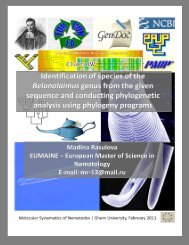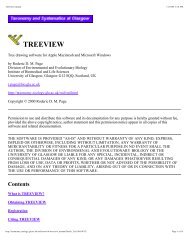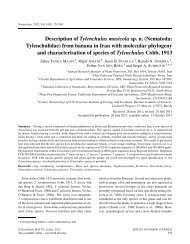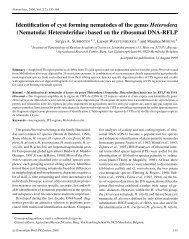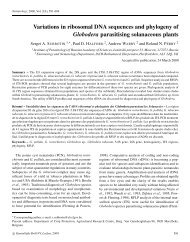Morphological and molecular characterisation of Californian species ...
Morphological and molecular characterisation of Californian species ...
Morphological and molecular characterisation of Californian species ...
You also want an ePaper? Increase the reach of your titles
YUMPU automatically turns print PDFs into web optimized ePapers that Google loves.
S. Álvarez-Ortega et al.<br />
Metaporcelaimus subhasi comb. n.: The conical elongate<br />
tail with finely rounded or acute tip <strong>of</strong> this <strong>species</strong><br />
supports its inclusion in Metaporcelaimus. Its original description<br />
is <strong>of</strong> poor quality, lacking many relevant morphological<br />
details. It is very similar, if not identical, to M.<br />
chauhani, a widely distributed <strong>species</strong> in India, <strong>and</strong> might<br />
be its junior synonym.<br />
Key to <strong>species</strong><br />
1. Pars refringens vaginae absent...................2<br />
Pars refringens vaginae present, with two well developed<br />
sclerotised pieces . . . . . . . . . . . . . . . . . . . . . . . . . . 8<br />
2. Lip region 12-13 μm wide; odontostyle 14 μm long<br />
.............................cylindricus comb. n.<br />
Lip region > 14 μm wide; odontostyle > 15 μm long<br />
...............................................3<br />
3. Lip region 20-22 μm wide; odontostyle 20-21 μm<br />
long; V = 59-61.................shamimi comb. n.<br />
Lip region < 20 μm wide; odontostyle < 19 μm<br />
long; V 58...................................4<br />
4. Body 2.6-3.1 mm long; neck 700-760 μmlong.....<br />
.......................................oceanicus<br />
Body < 2.5 mm long; neck < 550 μmlong.......5<br />
5. Lip region <strong>of</strong>fset by more or less marked depression;<br />
tail lacking any dorsal concavity . . . . . . . . . . . . . . . . . 6<br />
Lip region <strong>of</strong>fset by constriction; tail bearing a more<br />
or less developed dorsal concavity . . . . . . . . . . . . . . . 7<br />
6. Body 2.40-2.45 mm long <strong>and</strong> more slender (a = 49-<br />
50); pharyngeal expansion occupying 56-57% <strong>of</strong> total<br />
neck length; uterus > 2 body diam. long . . . . . . . . . . .<br />
.................................indicus comb. n.<br />
Body 1.51-2.09 mm long <strong>and</strong> more obese (a = 30-<br />
40); pharyngeal expansion occupying 48-56% <strong>of</strong> total<br />
neck length; uterus < 1.5 body diam. long . . . . . . . . .<br />
................................insignis comb. n.<br />
7. Body more slender (a = 38-51); comparatively<br />
shorter neck (b = 4.3-4.8); pharyngeal expansion occupying<br />
45-52% <strong>of</strong> total neck length; male present . .<br />
....................................ahmadi sp. n.<br />
Body more obese (a = 32-33); comparatively longer<br />
neck (b = 3.8-4.1); pharyngeal expansion occupying<br />
53-55% <strong>of</strong> total neck length; male absent . . . . . . . . . .<br />
.......................................coomansi<br />
8. Female tail conical with subacute or acute tip . . . . . 9<br />
Female tail conical with more rounded terminus . . 11<br />
9. Vulva more anterior, V 54; shorter neck, 1.5 mm long (including A. parangalitzi, 1.44-<br />
1.99 mm long) <strong>and</strong> more slender (a 26). . . . . . . .12<br />
12. Odontostyle up to 20 μmlong..................13<br />
Odontostyle > 20 μm long (including A. capitatus<br />
19-23 μm long) . . . . . . . . . . . . . . . . . . . . . . . . . . . . . . . 23<br />
13. Longer body, L > 2.50mmlong................14<br />
Shorter body, L < 2.50 mm long . . . . . . . . . . . . . . . . 18<br />
14. Female tail shorter, c ′ = 1.0-1.3.................15<br />
Female tail longer, c ′ 1.4.....................16<br />
15. Vulva more anterior, V = 49-53; 10-12 regularly<br />
spaced ventromedian supplements, the posteriormost<br />
one or two lying within range <strong>of</strong> spicules. . . . . . . . . . .<br />
......................................romanicus<br />
Vulva more posterior, V = 58; 8-9 regularly spaced<br />
ventromedian supplements lying outside range <strong>of</strong><br />
spicules..........................thornei comb. n.<br />
16. Body distinctly narrowing at level <strong>of</strong> odontophore<br />
base; odontostyle 14-16 μmlong..........labiatus<br />
Body not distinctly narrowing at level <strong>of</strong> odontophore<br />
base; odontostyle 19-20 μmlong...............17<br />
17. Body 2.8-2.9 mm long; neck 644-705 μm long; male<br />
absent......................donghwaens comb. n.<br />
Body 3.1-3.2 mm long; neck 711-721 μm long; male<br />
present...............................sublabiatus<br />
18. Female tail shorter, c ′ = 1.1-1.2.................19<br />
Female tail longer, c ′ 1.3.....................20<br />
19. Body 2.0 mm long; smaller odontostyle aperture<br />
(occupying ca 66% <strong>of</strong> total length); tail 50 μm long<br />
...............................raniensis comb. n.<br />
Body 1.8 mm long; larger odontostyle aperture (occupying<br />
ca 75% <strong>of</strong> total length); tail 36 μm long. . . .<br />
........................................efficiens<br />
20. Lipregion12μm wide; pharyngeal expansion occupying<br />
53-57% <strong>of</strong> total neck length . . . . . . . . . . . . . . . . .<br />
............................parangalitzi comb. n.<br />
Lip region > 14 μm wide; pharyngeal expansion<br />
occupying



